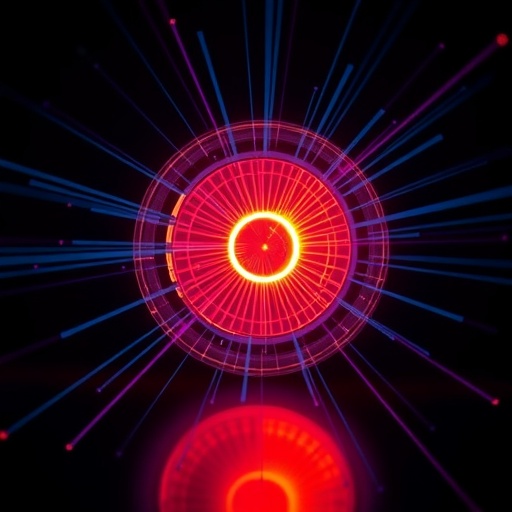A groundbreaking advancement has emerged from the collaborative efforts of researchers at the Max Born Institute (MBI) in Berlin and DESY in Hamburg, who have successfully developed a plasma lens capable of focusing attosecond light pulses. This achievement represents a significant leap forward in the field of ultrafast optics and attosecond science, promising to enhance the power and precision of attosecond light sources and unlocking new avenues for exploring electron dynamics with unprecedented temporal resolution.
Attosecond pulses are phenomenally brief bursts of light lasting on the order of billionths of a billionth of a second (10^-18 seconds). These pulses, typically found in the extreme ultraviolet (XUV) or X-ray spectral regions, serve as crucial probes for capturing and manipulating electron motion inside atoms, molecules, and solid materials. Despite their importance, the optical manipulation of such ultrashort light bursts has faced fundamental challenges, primarily due to the inadequacy of conventional optical components to handle such extreme temporal and spectral features.
Traditional focusing techniques rely on mirrors and lenses designed for visible light. XUV and X-ray mirrors generally suffer from low reflectivity and degrade quickly under intense irradiation, limiting their effectiveness for repeated use. On the other hand, glass or conventional lenses, which excel at focusing visible light, absorb XUV photons and significantly elongate the temporal profile of attosecond pulses, thus distorting their ultrashort nature. These limitations have hindered the ability of researchers to concentrate attosecond pulses efficiently, restricting experimental capabilities.
The team at MBI and DESY circumvented these obstacles through a novel approach: the creation of a plasma lens. This plasma lens is formed by sending a strong electrical pulse through a tiny capillary tube filled with hydrogen gas. The electrical pulse ionizes the hydrogen atoms, stripping them of their electrons and generating a plasma—a state where free electrons coexist with positively charged ions. Within the confined geometry of the capillary, the liberated electrons migrate toward the tube walls, leading to an organized charge distribution that effectively shapes the plasma into a concave lens geometry.
Unlike conventional lenses, the refractive behavior of plasma offers a unique benefit—it bends the incoming attosecond pulses in a way that focuses rather than diverges them. Normally, concave lenses spread light beams; however, the intricate interaction between the plasma’s electron density gradient and the electromagnetic fields of the attosecond pulses results in the opposite effect. This plasma lens thus serves as a robust, highly transmissive optical element optimized for the extreme spectral range and temporal brevity of attosecond pulses.
Their experimental outcomes, recently published in the prestigious journal Nature Photonics, demonstrate that the plasma lens can focus attosecond pulses efficiently across different XUV wavelengths. A key advantage of this technology lies in its tunability—the focal length can be dynamically controlled by adjusting the plasma density. This level of control offers unparalleled flexibility to researchers aiming to tailor their optical setups for a variety of pulse wavelengths and experimental demands.
One remarkable feature of this plasma lens is its high transmission rate, with over 80% of the attosecond pulse energy passing through the lens without significant losses. This efficiency starkly contrasts with traditional optics in the XUV regime, which often suffer from poor signal transmission. Moreover, the plasma lens inherently filters out the infrared light that drives the attosecond pulse generation, eliminating the need for thin metal filters typically employed in such experiments. This omission further enhances the throughput and power of the attosecond pulses delivered to the target.
To understand how the plasma lens affects the temporal profile of attosecond pulses, the researchers conducted detailed computer simulations. Their findings revealed that the pulse duration experiences only a minimal increase, extending slightly from 90 to 96 attoseconds. Under practical experimental conditions, where the pulses carry a chirp—a temporal spreading caused by different frequency components arriving at different times—the plasma lens actually acts to compress the pulse. Here, the duration is reduced from 189 to 165 attoseconds, demonstrating the lens’s ability to not just focus but also temporally refine the ultrafast light bursts.
This innovative plasma lens technology addresses long-standing limitations in attosecond optics by offering straightforward alignment and compatibility with multiple wavelengths, thereby facilitating easier integration into existing experimental frameworks. The flexibility, simplicity, and high performance of the lens pave the way for more accessible and powerful attosecond science experiments worldwide.
The potential impact of this development extends beyond fundamental research. Fine-tuned attosecond pulses can be harnessed to advance quantum information technologies by enabling control of electron wave packets on ultrafast timescales. Additionally, the plasma lens sets the stage for the next generation of ultrafast microscopy techniques, which rely on highly focused, short pulses to capture transient phenomena at the nanoscale.
In sum, the creation of the attosecond plasma lens represents a milestone that unlocks greater experimental intensity and temporal precision in XUV and X-ray optics. The study not only showcases an elegant solution to longstanding technical problems but also promises to accelerate discoveries in physics, chemistry, and materials science by enabling new ways to probe and manipulate matter at its most fundamental electron time scales.
By harnessing the unique refractive properties of plasma, the researchers have opened an intriguing new chapter in ultrafast optics. The ongoing exploration and optimization of these plasma lenses will likely catalyze transformative advances across many scientific disciplines and emerging technologies in the years to come.
Subject of Research: Not applicable
Article Title: Plasma lens for focusing attosecond pulses
News Publication Date: 4-Nov-2025
Web References: https://doi.org/10.1038/s41566-025-01794-y
Image Credits: MBI / Evaldas Svirplys
Keywords
Attosecond pulses, plasma lens, ultrafast optics, extreme ultraviolet, XUV focusing, plasma optics, electron dynamics, X-ray optics, ultrafast microscopy, attosecond science, pulse compression, nonlinear optics
Tags: attosecond plasma lens technologychallenges in attosecond scienceDESY Hamburg collaborationelectron dynamics explorationextreme ultraviolet light pulsesinnovative focusing techniques for XUVMax Born Institute research breakthroughsoptical manipulation of ultrashort lightprecision in light source enhancementtemporal resolution in electron motionultrafast optics advancementsX-ray spectral region applications





